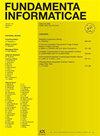Shelah-Stupp's Iteration and Muchnik's Iteration
IF 0.4
4区 计算机科学
Q4 COMPUTER SCIENCE, SOFTWARE ENGINEERING
引用次数: 1
Abstract
In the early seventies, Shelah proposed a model-theoretic construction, nowadays called "iteration". This construction is an infinite replication in a tree-like manner where every vertex possesses its own copy of the original structure. Stupp proved that the decidability of the monadic second-order (MSO) theory is transferred from the original structure onto the iterated one. In its extended version discovered by Muchnik and introduced by Semenov, the iteration became popular in computer science logic thanks to a paper by Walukiewicz. Compared to the basic iteration, Muchnik’s iteration has an additional unary predicate which, in every copy, marks the vertex that is the clone of the possessor of the copy. A widely spread belief that this extension is crucial is formally confirmed in the paper. Two hierarchies of relational structures generated from finite structures by MSO interpretations and either Shelah-Stupp’s iteration or Muchnik’s iteration are compared. It turns out that the two hierarchies coincide at level 1. Every level of the latter hierarchy is closed under Shelah-Stupp’s interation. In particular, the former hierarchy collapses at level 1.Shelah-Stupp的迭代和Muchnik的迭代
70年代初,希拉提出了一种模型论的构造,现在称为“迭代”。这种结构以树状的方式无限复制,其中每个顶点都拥有原始结构的副本。Stupp证明了一元二阶(MSO)理论的可判据性从原始结构转移到迭代结构。在Muchnik发现并由Semenov介绍的扩展版本中,迭代在计算机科学逻辑中流行起来,这要归功于Walukiewicz的一篇论文。与基本迭代相比,Muchnik的迭代有一个额外的一元谓词,在每个副本中,它标记了副本所有者的克隆顶点。这篇论文正式证实了一种广泛传播的观点,即这种扩展是至关重要的。比较了MSO解释和Shelah-Stupp迭代法和Muchnik迭代法在有限结构中生成的两种关系结构层次。事实证明,这两个层次结构在第1层重合。后一层次的每一层都在Shelah-Stupp的定义下关闭。特别是,以前的层次结构在第1级崩溃。
本文章由计算机程序翻译,如有差异,请以英文原文为准。
求助全文
约1分钟内获得全文
求助全文
来源期刊

Fundamenta Informaticae
工程技术-计算机:软件工程
CiteScore
2.00
自引率
0.00%
发文量
61
审稿时长
9.8 months
期刊介绍:
Fundamenta Informaticae is an international journal publishing original research results in all areas of theoretical computer science. Papers are encouraged contributing:
solutions by mathematical methods of problems emerging in computer science
solutions of mathematical problems inspired by computer science.
Topics of interest include (but are not restricted to):
theory of computing,
complexity theory,
algorithms and data structures,
computational aspects of combinatorics and graph theory,
programming language theory,
theoretical aspects of programming languages,
computer-aided verification,
computer science logic,
database theory,
logic programming,
automated deduction,
formal languages and automata theory,
concurrency and distributed computing,
cryptography and security,
theoretical issues in artificial intelligence,
machine learning,
pattern recognition,
algorithmic game theory,
bioinformatics and computational biology,
quantum computing,
probabilistic methods,
algebraic and categorical methods.
 求助内容:
求助内容: 应助结果提醒方式:
应助结果提醒方式:


